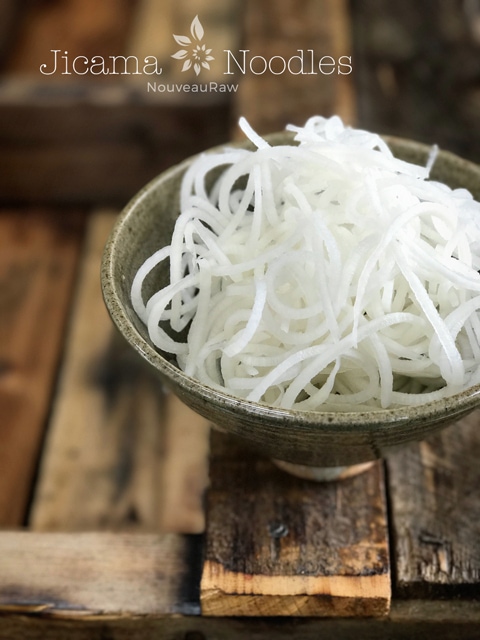Jicama Noodles

 Add to favorites
Add to favorites

~ raw, vegan, gluten-free, nut-free, alkaline ~
What is round, bulbous, firm, juicy, and tan in color? Yep, you guessed it! A jicama! It is a root vegetable and believe it or not it is part of the legume family and grows on vines (its vine can grow up to 20 feet in length!).
A root vegetable that grows on a vine?! Texture-wise, it is similar to a turnip but tastes like an apple or perhaps a cross between a water chestnut and a pear, maybe even a little nutty? It can be hard to describe. The flesh is crisp, white, and solid.
They are low in calories but high in a few vital nutrients. It provides one-quarter of our daily need in fiber per serving. But we are not just talking about any fiber here… jicama’s fiber is infused with oligofructose inulin. This inulin promotes bone health by enhancing the absorption of calcium from other foods, protecting against osteoporosis. Inulin has a prebiotic role in the intestine that promotes “good” bacteria growth which helps to maintain a healthy colon and balanced immunity.
Jicama is also very low on the glycemic index, which makes it a great food for diabetics. Those are just a few of the amazing benefits we get from eating this round, bulbous, firm, and juicy item. :)
When scouting out jicama at the supermarket, look for firm, round tubers, pass up the ones that are shriveled, bruised, or blemished. Store them in a cool, dark place for up to four weeks, and keep them in the fridge after they have been cut.
Jicama pairs well with acidic fruits and juices such as grapefruit, lime, lemon, and orange juice. It might even surprise you to know that it is complemented by ground red pepper and hot pepper sauce. Thinking Mexican cuisine? Jicama goes well with avocado, cilantro, and cucumber.
 Ingredients:
Ingredients:
Preparation:
- Be sure to pick the freshest, jicama root that you can find. This will ensure that you get the best tasting noodles possible.
- Look for firm roots. If the flesh is mushy, it won’t work on the spiralizer.
- With a potato peeler, remove the skin and then cut a flat top and bottom.
- Place the unit on the countertop and press down on the spiralizer to engage the suction cups and secure.
- Insert the blade cartridge you’d like to use, make sure that it clicks into place.
- Place the center of the root onto the cylinder part of the blade and press the teeth of the handle into the other side of it.
- Take hold of the handle on the bottom (the horizontal one) with one hand and then spin the handle with the teeth to spiralize. Press steadily with forward pressure, using the handle that you’re gripping, for best results.
- Before dressing up the noodles, take scissors when you’re done spiralizing and cut the noodles into manageable sized pieces. Just grab a bunch of noodles and roughly snip. Or enjoy that never-ending noodle!
- You can make noodles in advance, they should keep for 5-7 days in the fridge, without sauce.
To clean the spiralizer:
- Purchase an inexpensive handled brush for cleaning the blade parts and hard to reach parts on the unit. This will save your fingers and prevent nicks from happening on the blades, keeping them nice and sharp.
- Be sure to quickly rinse the unit after creating noodles. The juices from certain root veggies can stain the unit.
- Dry the blades well before putting them away.
Tools used to create noodles:
GEFU Spiralfix Spiral Slicer
- Can be used in the left or right hand.
- 4 different widths of cut for creative recipes: Spiral cut across the entire width of the material, 3 mm, 6 mm, or 12 mm wide adjustable via adjusting wheel
- Folding lid for easy filling
- Detachable non-slip holding container for safe standing
- Material: stainless steel, ABS plastic, SAN
- Splash-guard lid with drive unit detachable for easy cleaning. Dishwasher-safe
Spiralizer 7-Blade Vegetable Slicer
- This slicer comes with 7 different blades which give you 7 completely different textures and shapes.
- Comes with 420 high carbon cutlery grade stainless steel blades and stronger making it possible to Spiralize harder root vegetables like sweet potatoes and turnips that previously broke Spiralizer handles
Potato Peeler
- Wash and peel the outer skin off of the veggie.
- Hold the veggie at one end and in a long stroke motion, run the peeler from top to bottom.
- Rotate the veggie in a circular motion and continue peeling until you reach the seeded core (if there is one). Stop once you reach this. Don’t throw it away, use it in a smoothie or salad.
© AmieSue.com
Tags: Alkaline, Dairy Free, Gluten Free, No Dehydration Required, Nut Free, Refined Sugar Free, Soy Free, Vegan



 Add to favorites
Add to favorites
 Ingredients:
Ingredients: